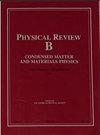Observation of flat and weakly dispersing bands in the van der Waals semiconductor Nb3Br8
IF 3.7
2区 物理与天体物理
Q2 MATERIALS SCIENCE, MULTIDISCIPLINARY
引用次数: 0
Abstract
Niobium halides, Nb3X8 (X = Cl,Br,I), which are predicted two-dimensional magnets, have recently gotten attention due to their breathing kagome geometry. Here, we have studied the electronic structure of Nb3Br8 by using angle-resolved photoemission spectroscopy (ARPES) and first-principles calculations. ARPES results depict the presence of multiple flat and weakly dispersing bands. These bands are well explained by the theoretical calculations, which show they have Nb d character indicating their origination from the Nb atoms forming the breathing kagome plane. This van der Waals material can be easily thinned down via mechanical exfoliation to the ultrathin limit and such ultrathin samples are stable as depicted from the time-dependent Raman spectroscopy measurements at room temperature. These results demonstrate that Nb3Br8 is an excellent material not only for studying breathing kagome induced flat band physics and its connection with magnetism, but also for heterostructure fabrication for application purposes.范德华半导体Nb3Br8<中平坦和弱色散带的观察
卤化铌Nb3X8(X=Cl,Br,I)是一种预测的二维磁体,由于其呼吸kagome几何形状,最近受到了关注。在这里,我们利用角度分辨光电发射光谱(ARPES)和第一性原理计算研究了Nb3Br8的电子结构。ARPES结果描述了多个平坦和弱散射带的存在。理论计算很好地解释了这些谱带,表明它们具有Nb-d特征,表明它们起源于形成呼吸kagome平面的Nb原子。这种范德华材料可以通过机械剥离很容易地减薄到超薄极限,并且这种超薄样品是稳定的,如室温下随时间变化的拉曼光谱测量所示。这些结果表明,Nb3Br8不仅是研究呼吸戈姆诱导的平带物理及其与磁性的联系的优良材料,而且也是用于应用目的的异质结构制造的优良材料。
本文章由计算机程序翻译,如有差异,请以英文原文为准。
求助全文
约1分钟内获得全文
求助全文
来源期刊

Physical Review B
PHYSICS, CONDENSED MATTER-
CiteScore
6.30
自引率
32.40%
发文量
4177
期刊介绍:
Physical Review B (PRB) is the world’s largest dedicated physics journal, publishing approximately 100 new, high-quality papers each week. The most highly cited journal in condensed matter physics, PRB provides outstanding depth and breadth of coverage, combined with unrivaled context and background for ongoing research by scientists worldwide.
PRB covers the full range of condensed matter, materials physics, and related subfields, including:
-Structure and phase transitions
-Ferroelectrics and multiferroics
-Disordered systems and alloys
-Magnetism
-Superconductivity
-Electronic structure, photonics, and metamaterials
-Semiconductors and mesoscopic systems
-Surfaces, nanoscience, and two-dimensional materials
-Topological states of matter
 求助内容:
求助内容: 应助结果提醒方式:
应助结果提醒方式:


